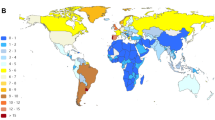Abstract
Plasma levels of the inflammatory biomarker soluble urokinase plasminogen activator (suPAR) have been shown to carry prognostic information in various infectious and inflammatory diseases. The present study aimed to compare the prognostic value of urine suPAR (U-suPAR) to that of plasma suPAR (P-suPAR), thereby exploring the possibility of replacing the blood sample with an easy obtainable urine sample. We enrolled 1,007 adults, older than 15 years of age, with a negative TB diagnosis between April 2004 and December 2006. Levels of U-suPAR and P-suPAR were available in 863 individuals. U-suPAR was measured using a commercial ELISA (suPARnostic®). We found that U-suPAR carried significant prognostic information on mortality for HIV-infected subjects with an area under the ROC curve of 0.75. For HIV-negative individuals, little or no prognostic effect was observed. However, in both HIV positives and negatives, the predictive effect of U-suPAR was found to be inferior to that of P-suPAR.



Similar content being viewed by others
References
Rabna, P., A. Andersen, C. Wejse, et al. 2009. High mortality risk among individuals assumed to be TB-negative can be predicted using a simple test. Tropical Medicine and International Health 14(9): 986–94.
Sidenius, N., C.F. Sier, H. Ullum, et al. 2000. Serum level of soluble urokinase-type plasminogen activator receptor is a strong and independent predictor of survival in human immunodeficiency virus infection. Blood 96(13): 4091–5.
Ostrowski, S.R., T. Piironen, G. Hoyer-Hansen, J. Gerstoft, B.K. Pedersen, and H. Ullum. 2005. High plasma levels of intact and cleaved soluble urokinase receptor reflect immune activation and are independent predictors of mortality in HIV-1-infected patients. Journal of Acquired Immune Deficiency Syndromes 39(1): 23–31.
Eugen-Olsen, J., P. Gustafson, N. Sidenius, et al. 2002. The serum level of soluble urokinase receptor is elevated in tuberculosis patients and predicts mortality during treatment: a community study from Guinea-Bissau. International Journal of Tuberculosis and Lung Disease 6(8): 686–692.
Wittenhagen, P., G. Kronborg, N. Weis, et al. 2004. The plasma level of soluble urokinase receptor is elevated in patients with Streptococcus pneumoniae bacteraemia and predicts mortality. Clinical Microbiology and Infection 10(5): 409–415.
Kofoed, K., J. Eugen-Olsen, J. Petersen, K. Larsen, and O. Andersen. 2008. Predicting mortality in patients with systemic inflammatory response syndrome: an evaluation of two prognostic models, two soluble receptors, and a macrophage migration inhibitory factor. European Journal of Clinical Microbiology and Infectious Diseases 27(5): 375–383.
Olson, F.J., T.T. Sorensen, M. Ryndel, G. Hoyer-Hansen, and B. Fagerberg. 2010. Soluble urokinase-type plasminogen activator receptor forms in plasma as markers of atherosclerotic plaque vulnerability. Clinical Biochemistry 43(1–2): 124–130.
Sidenius, N., and F. Blasi. 2003. The urokinase plasminogen activator system in cancer: recent advances and implication for prognosis and therapy. Cancer and Metastasis Reviews 22(2–3): 205–222.
Andersen, O., J. Eugen-Olsen, K. Kofoed, J. Iversen, and S.B. Haugaard. 2008. Soluble urokinase plasminogen activator receptor is a marker of dysmetabolism in HIV-infected patients receiving highly active antiretroviral therapy. Journal of Medical Virology 80(2): 209–216.
Slot, O., N. Brunner, H. Locht, P. Oxholm, and R.W. Stephens. 1999. Soluble urokinase plasminogen activator receptor in plasma of patients with inflammatory rheumatic disorders: increased concentrations in rheumatoid arthritis. Annals of the Rheumatic Diseases 58(8): 488–492.
Fevang, B., J. Eugen-Olsen, A. Yndestad, et al. 2009. Enhanced levels of urokinase plasminogen activator and its soluble receptor in common variable immunodeficiency. Clinical Immunology 131(3): 438–446.
Sidenius, N., C.F. Sier, and F. Blasi. 2000. Shedding and cleavage of the urokinase receptor (uPAR): identification and characterisation of uPAR fragments in vitro and in vivo. FEBS Letters 475(1): 52–56.
Sier, C.F., N. Sidenius, A. Mariani, et al. 1999. Presence of urokinase-type plasminogen activator receptor in urine of cancer patients and its possible clinical relevance. Laboratory Investigation 79(6): 717–722.
Kofoed, K., U.V. Schneider, T. Scheel, O. Andersen, and J. Eugen-Olsen. 2006. Development and validation of a multiplex add-on assay for sepsis biomarkers using xMAP technology. Clinical Chemistry 52(7): 1284–1293.
Sier, C.F., R. Stephens, J. Bizik, et al. 1998. The level of urokinase-type plasminogen activator receptor is increased in serum of ovarian cancer patients. Cancer Research 58(9): 1843–1849.
Mustjoki, S., N. Sidenius, C.F. Sier, et al. 2000. Soluble urokinase receptor levels correlate with number of circulating tumor cells in acute myeloid leukemia and decrease rapidly during chemotherapy. Cancer Research 60(24): 7126–7132.
Acknowledgements
The authors are grateful to the staff at the Bandim Health Project, National Public Health Laboratory and Hvidovre Hospital in Copenhagen, Denmark for carrying out patient recruitment, microscopy examinations and suPAR measurements. Further thanks to the staff at Hvidovre Hospital for teaching local Guinean staff the technique of suPAR measurement. We thank the study subjects for their participation.
Competing Interests
Jesper Eugen-Olsen is a shareholder in ViroGates, the company that produces the suPARnostic assay, and has patents on the use of suPAR. The other authors have no conflicts of interest to declare.
Authors' Contributions
Study design: Paulo Rabna, Christian Wejse, Peter Aaby, Jesper Eugen-Olsen; Study Implementation and data collection: Paulo Rabna, Christian Wejse, Ines Oliveira, Victor Francisco Gomes, Maya Bonde Haaland; Manuscript writing: Paulo Rabna, Andreas Andersen; Data analysis: Andreas Andersen, Paulo Rabna; Final manuscript review: all authors.
Funding Sources
The study was funded by the EU FP6 project number LSSP-CT-2005-012173. The funding Institution had no influence on design, and conduct of the study or on preparation, review and approval of the manuscript, neither on analysis, interpretation of the data or decision to publish.
Author information
Authors and Affiliations
Corresponding author
Rights and permissions
About this article
Cite this article
Rabna, P., Andersen, A., Wejse, C. et al. Urine suPAR Levels Compared with Plasma suPAR Levels as Predictors of Post-consultation Mortality Risk Among Individuals Assumed to be TB-negative: A Prospective Cohort Study. Inflammation 33, 374–380 (2010). https://doi.org/10.1007/s10753-010-9195-2
Published:
Issue Date:
DOI: https://doi.org/10.1007/s10753-010-9195-2




